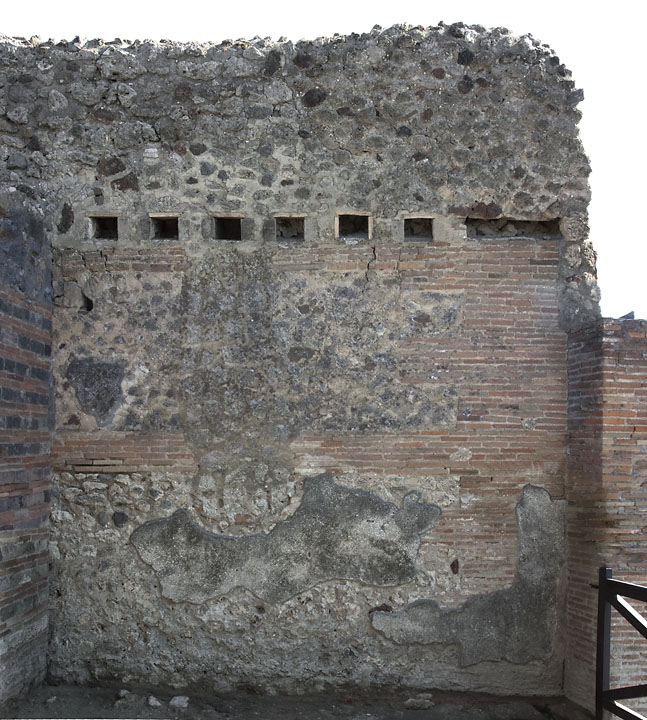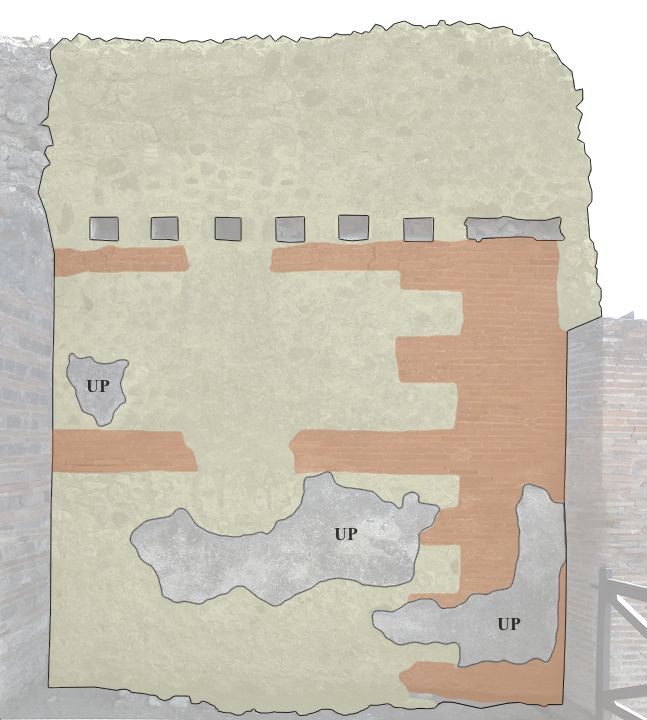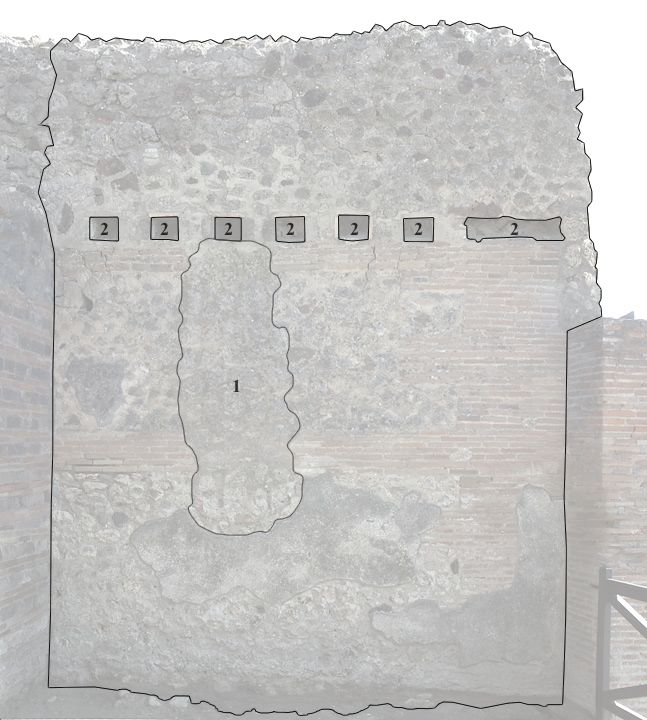South Wall
Description
Mats Holmlund
Ground floor
The wall is built in opus mixtum. It’s 3.75 m wide and 3.25 m high in the east corner and 3.35 m high in the west. The lower and upper part of the wall is built in opus incertum, while the construction method of the west corner, the middle and top part of the wall is opus testaceum. The first (lower) part of incertum begins at the east corner and is 2.55 to 2.90 m wide (the interval is due to the fact that the testaceum part of the wall is crenelated). It stretches from the ground level up to circa 1.60 m and it is made up of limestone, lava and cruma. The upper part has the same width as the lower part of the wall, and it begins circa 1.90 m from the ground level and ends 3.00 m from the ground. The upper part is also made up of limestone, lava and cruma.
The testaceum part makes up the entire west corner of the wall. It’s approximately 0.80 to 1.20 m wide and 3.30 m high. In the middle of the wall (circa 1.60 to 1.90 m from the ground level), a row of seven tiers of tiles spans the entire wall. At the top of the wall, circa 3.00 to 3.20 m from the ground, another row of tiles (this one consist of four tiers) span the wall. The tiles vary in size from 0.15 to 0.25 m wide and 0.02 to 0.04 m high.
In the west corner of the upper part of the wall, there’s a small area of opus incertum outside the opus testaceum (that is, it rests on top of the west wall/south doorpost of the entry to the taberna). It stretches from circa 2.65 to 3.30 m and is most likely a restoration.
In the middle of the wall there’s a (repaired) breach made by tunnel-diggers. The breach is circa 0.80 m wide and 2.00 m high, and located circa 1.00 m from the east corner and 1.20 m from the ground level. There is a piece of spolia from a cocciopesto floor inserted in the wall.
The mortar of both the incertum and testaceum parts of the wall is yellowish grey and contains grains of limestone and lava. This doesn’t include the incertum part in the upper west corner, where the mortar is dark grey. The mortar of the repaired hole also differs from the other parts of the wall. The mortar of this area is yellowish grey, but darker and coarser than the mortar of the incertum and testaceum parts.
At the lower part of the wall there is an area of plaster stretching from circa 0.60 m from the east corner to 0.90 m from the west corner, and from 0.60 m from the ground level to the first row of tiles. Another, (inverse) L-shaped area of wall plaster stretches from the west corner to circa 1.40 m from that corner, and from about 0.30 m from the ground level up to the first row of tiles. Lastly, in the upper part of the wall there is a small, "triangular" (turned upside down) area of plaster, which is circa 0.40 m wide (the base) and 0.45 m high. It is located 0.10 m from the east corner and right above the first row of tiles. In all areas, only the subsurface of the plaster remains.
Upper floor
The wall of the upper floor is built in opus incertum. It’s circa 3.90 m wide and 1.35 m high at its highest point (the reason it’s wider than the first floor wall, is that it also spans the restored incertum part on top of the west wall). It consists of limestone, lava and cruma.
There are six extant beam holes (probably eight originally). They are circa 0.20 m wide and 0.20 m high. The last two have merged into one large hole that’s approximately 0.65 m wide and 0,20 m high. The six extant holes have been restored in modern times and are marked with pieces of tile. There is one spolia visible in the wall; a piece travertine that is located circa 0.70 m from the east corner and 0.40 m above the beam holes.
Above the beam holes, from circa 1.00 m from the east corner to the west corner, modern mortar has been applied to the wall (to prevent the original mortar from wither away). At its highest point this application of modern mortar stretches 0.80 m up from the beam holes, but usually it varies between 0.20 to 0.50 m in height.



